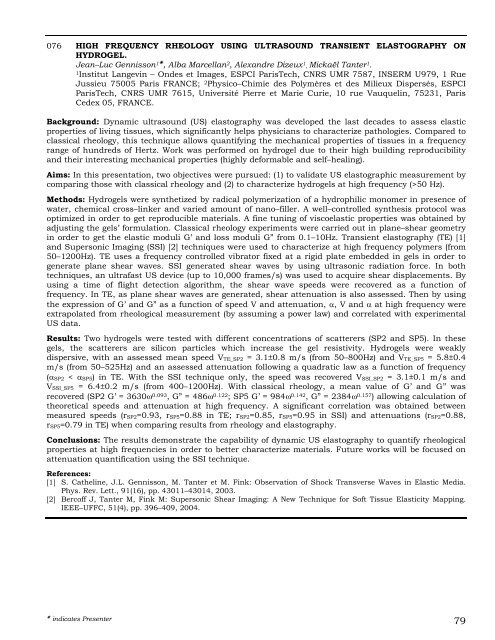2012 Proceedings - International Tissue Elasticity Conference
2012 Proceedings - International Tissue Elasticity Conference
2012 Proceedings - International Tissue Elasticity Conference
You also want an ePaper? Increase the reach of your titles
YUMPU automatically turns print PDFs into web optimized ePapers that Google loves.
076 HIGH FREQUENCY RHEOLOGY USING ULTRASOUND TRANSIENT ELASTOGRAPHY ON<br />
HYDROGEL.<br />
Jean–Luc Gennisson 1 , Alba Marcellan 2 , Alexandre Dizeux 1 , Mickaël Tanter 1 .<br />
1 Institut Langevin – Ondes et Images, ESPCI ParisTech, CNRS UMR 7587, INSERM U979, 1 Rue<br />
Jussieu 75005 Paris FRANCE; 2 Physico–Chimie des Polymères et des Milieux Dispersés, ESPCI<br />
ParisTech, CNRS UMR 7615, Université Pierre et Marie Curie, 10 rue Vauquelin, 75231, Paris<br />
Cedex 05, FRANCE.<br />
Background: Dynamic ultrasound (US) elastography was developed the last decades to assess elastic<br />
properties of living tissues, which significantly helps physicians to characterize pathologies. Compared to<br />
classical rheology, this technique allows quantifying the mechanical properties of tissues in a frequency<br />
range of hundreds of Hertz. Work was performed on hydrogel due to their high building reproducibility<br />
and their interesting mechanical properties (highly deformable and self–healing).<br />
Aims: In this presentation, two objectives were pursued: (1) to validate US elastographic measurement by<br />
comparing those with classical rheology and (2) to characterize hydrogels at high frequency (>50 Hz).<br />
Methods: Hydrogels were synthetized by radical polymerization of a hydrophilic monomer in presence of<br />
water, chemical cross–linker and varied amount of nano–filler. A well–controlled synthesis protocol was<br />
optimized in order to get reproducible materials. A fine tuning of viscoelastic properties was obtained by<br />
adjusting the gels’ formulation. Classical rheology experiments were carried out in plane–shear geometry<br />
in order to get the elastic moduli G’ and loss moduli G” from 0.1–10Hz. Transient elastography (TE) [1]<br />
and Supersonic Imaging (SSI) [2] techniques were used to characterize at high frequency polymers (from<br />
50–1200Hz). TE uses a frequency controlled vibrator fixed at a rigid plate embedded in gels in order to<br />
generate plane shear waves. SSI generated shear waves by using ultrasonic radiation force. In both<br />
techniques, an ultrafast US device (up to 10,000 frames/s) was used to acquire shear displacements. By<br />
using a time of flight detection algorithm, the shear wave speeds were recovered as a function of<br />
frequency. In TE, as plane shear waves are generated, shear attenuation is also assessed. Then by using<br />
the expression of G’ and G” as a function of speed V and attenuation, α, V and α at high frequency were<br />
extrapolated from rheological measurement (by assuming a power law) and correlated with experimental<br />
US data.<br />
Results: Two hydrogels were tested with different concentrations of scatterers (SP2 and SP5). In these<br />
gels, the scatterers are silicon particles which increase the gel resistivity. Hydrogels were weakly<br />
dispersive, with an assessed mean speed VTE_SP2 = 3.1±0.8 m/s (from 50–800Hz) and VTE_SP5 = 5.8±0.4<br />
m/s (from 50–525Hz) and an assessed attenuation following a quadratic law as a function of frequency<br />
(αSP2 < αSP5) in TE. With the SSI technique only, the speed was recovered VSSI_SP2 = 3.1±0.1 m/s and<br />
VSSI_SP5 = 6.4±0.2 m/s (from 400–1200Hz). With classical rheology, a mean value of G’ and G’’ was<br />
recovered (SP2 G’ = 3630ω 0.093 , G” = 486ω 0.122 ; SP5 G’ = 984ω 0.142 , G” = 2384ω 0.157 ) allowing calculation of<br />
theoretical speeds and attenuation at high frequency. A significant correlation was obtained between<br />
measured speeds (rSP2=0.93, rSP5=0.88 in TE; rSP2=0.85, rSP5=0.95 in SSI) and attenuations (rSP2=0.88,<br />
rSP5=0.79 in TE) when comparing results from rheology and elastography.<br />
Conclusions: The results demonstrate the capability of dynamic US elastography to quantify rheological<br />
properties at high frequencies in order to better characterize materials. Future works will be focused on<br />
attenuation quantification using the SSI technique.<br />
References:<br />
[1] S. Catheline, J.L. Gennisson, M. Tanter et M. Fink: Observation of Shock Transverse Waves in Elastic Media.<br />
Phys. Rev. Lett., 91(16), pp. 43011–43014, 2003.<br />
[2] Bercoff J, Tanter M, Fink M: Supersonic Shear Imaging: A New Technique for Soft <strong>Tissue</strong> <strong>Elasticity</strong> Mapping.<br />
IEEE–UFFC, 51(4), pp. 396–409, 2004.<br />
indicates Presenter 79









